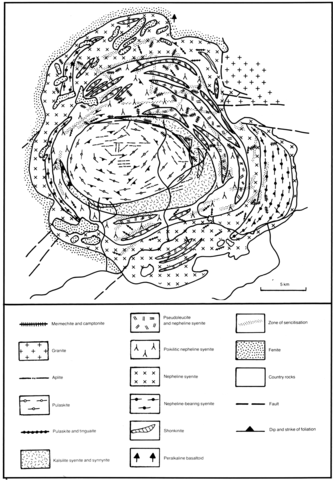stripes
The Synnyr pluton is oval in shape, covers564 km2 and cuts Lower Cambrian limestones, conglomerates and sandstones and Palaeozoic granitoids. The massif has a zonal structure: the central part is made of trachytic alkaline syenites (pulaskites) around which are more extensive rings of pseudoleucite and nepheline syenite. From the centre to the peripheral parts of the massif the following succession of rocks occurs: alkaline syenites – pseudoleucite syenites – pseudoleucite microcline syenites – pseudoleucite nepheline-microcline syenites – nepheline syenites. The central oval-shaped stock has an area of about100 km2 and is composed of trachytic pyroxene alkaline syenites which are mainly pulaskites. The alkaline syenites making up the stock have a relatively uniform composition, but nevertheless the inner parts are more leucocratic than the marginal ones, containing, besides microcline, only 3-7% of coloured minerals (aegirine-augite, hornblende). In the marginal parts of the stock up to 10% nepheline appears in the alkaline syenites and the proportion of coloured minerals is higher, usually with pyroxene up to 20 %, and in places there is up to 15% hornblende and up to 5% biotite. In parallel with these zonal changes the volume of accessories increases towards the margin, especially of titanite, magnetite and apatite. The inner ring of pseudoleucite rocks is adjacent to the pulaskite stock and forms a ring 0.5-4 km wide around it.These rocks are rather variable in composition and structure. One of the varieties of pseudoleucite rock is synnyrite which consists of dactylotypic intergrowths of orthoclase and microcline with kalsilite and nepheline, in which the ratio of K-feldspar to to kalsilite ± nepheline is 61-67: 39-33. The K2O of these rocks can reach 18-20%. In the pseudoleucite syenites microcline and nepheline are present as isolated crystals in pseudoleucite micrographical intergrowths, so that pseudoleucite-microcline syenites and pseudoleucite-nepheline-microcline syenites can be distiguished. The proportion of pseudoleucite in these rocks is extremely variable and up to 50-60%. The marginal ring of nepheline syenites varies in width from 1-2 60 6-8 km. The nepheline syenites are miaskitic, medium- and coarse-grained rocks with allotriomorphic granular, occasionally indistinctly porphyritic, or poikilitic hypidiomorphic granular textures. Microcline (45-85%), infrequent orthoclase (sanidine), nepheline (5-45%), with very small mica inclusions, cancrinite, aegirine and mica (1-5%) are modally dominant. In foyaites the amount of biotite decreases to about 1%, but clinopyroxene increases up to 25-30%. Accessory minerals are apatite, magnetite, titanite, occasionally rutile, eudialyte, zircon, melanite, perovskite and badeleyite. Initial Sr ratios of 0.7064 have been obtained from synnyrite and 0.7066 from nepheline syenite (Zhidkov, 1990). The order of emplacement of the various rock typesis not clear and is being debated. According to Andre’E v (1981) the peralkaline syenites were formed before the feldspathoidal syenites. During the final stages a variable series of dykes were emplaced which include tinguaite, shonkinite, camptonite and monchiquite. At the outer contact of nepheline syenite with Cambrian marbles and dolomite, skarns having variable compositions are present. They can include forsterite-calcite and diopside-hedenbergite rocks with vesuvianite, phlogopite, spinel, wollastonite, epidote and magnetite. At contacts with terrigenous and volcanic rocks hornfelses with epidote, biotite, andalusite, corundum, staurolite and kyanite have been formed. For mineral and rock compositions refer to Arkhangelskaya (1974), Andre’E v (1981) and Zhidkov (1990); δO18 values of 8.0-9.5 were obtained by Pokrovskii and Zhidkov (1993).
ANDRE’E V, G.V. 1981. Petrology of the association of the potassium, nepheline and peralkaline syenites. Nauka, Novosibirsk, 85 pp.
*ANDRE’E V, G.V., POSOKHOV, V.F. and SHALAGIN, V.L. 1991. The age of the Synnyr intrusion. Geochemistry International, 28(12): 99-102.
ARKHANGELSKAYA, V.V. 1974. Rare-metal alkaline complexes of the southern margin of the Siberian platform. Nedra, Moscow, 128 pp.
PANINA, L.I. 1972. Mineral-genetic characteristic features of some alkaline massifs of the Baikal area. Nauka, Siberian Branch of the USSR Academy of Sciences, Novosibirsk, 127 pp.
*POKROVSKII, B.G. and ZHIDKOV, A.Ya. 1993. Origin of the ultrapotassic rocks of the Synnyr and southern Sakun massifs (Transbaikal area) from isotopic data evidence. Petrology, 1: 195-204.
ZHIDKOV, A.Ya. 1968. Apatite-bearing alkaline intrusions of the North Baikal area. In V.I. Smirnov et al. (eds) Apatite, 126-132. Nauka, Moscow.
ZHIDKOV, A.Ya. 1990. Palaeozoic stage of magmatism. In G.V. Pol'akov and V.V. Kepezinskas (eds) Potassium alkaline magmatism of the Baikal-Stanovoy rifting system. 32-64. Nauka, Siberian Branch of the Academy of Sciences, Novosibirsk.

